Hiroshima
We went to Hiroshima with one aim in mind: to see the Hiroshima Peace Memorial. So focused were we that I actually never really researched anything else we might want to do. The goal was to see the memorial and then take the ferry right from the Peace Park across the bay to Istukushima, better known as Miyajima, the Shrine Island. It also took full advantage of our rail passes, taking us a full 500 miles from Tokyo. The final few minutes of the journey reminded me a little of the Riviera. Low but very steep-sided valleys, so the train just alternated between bridges and tunnels. It's a bit like being in a model railway layout.
As we exited the station, I grabbed a tourist map and we found the hotel marked on it. It was fairly obvious that to get to the A-Bomb Dome we needed to take the #2 tram, which we jumped right on. We could see that the hotel was a little off the route, but basically between the station and the park, so we got off at the closest point to the hotel to drop our bags off first. Setting off again in a much lighter state, we passed a parking garage that was in so little space it was like the rack at the dry cleaners. You drove into the entrance, and stopped. As you walked away the car disappeared on the belt or whatever it was, and the next car could drive in. When you returned, they dialled your car up again and it reappeared, just like you left it, pointing into the garage, So you reverse out onto a turntable which rotated the car 180 so you could exit face-first into the traffic. Amazing.
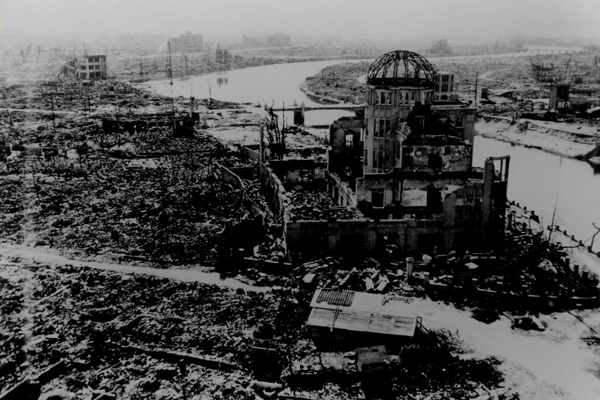 We escaped the heat by using an underground mall that seemed to be headed in the right direction. Lots of strange and exotic stores including one that only sold umbrellas, but my personal favorite was "Caiopanic Clothing" whatever that means. I didn't see any towels designed for intergalactic travel, but the prices definitely were, and even Adam choked, putting back several clothing items that he would have otherwise snagged. Caiopanic indeed.
We escaped the heat by using an underground mall that seemed to be headed in the right direction. Lots of strange and exotic stores including one that only sold umbrellas, but my personal favorite was "Caiopanic Clothing" whatever that means. I didn't see any towels designed for intergalactic travel, but the prices definitely were, and even Adam choked, putting back several clothing items that he would have otherwise snagged. Caiopanic indeed.
We came back up to street level and there was the dome. A haunting site, somehow the more so for reminding me so much of the war photos that for some reason I remember so clearly, but now here it was in full color, surrounded by new buildings and life, and yet so very definitely unmoved, unchanged.
As I gave my Japan slide show to folks, I realized how difficult it was to convey how moving the Peace Memorial was, by which I mean specifically the A-Bomb Dome. What seemed to work, and therefore I have replicated here, is to a) provide a little historical background, b) show one of the famous post-bombing pictures I grabbed from the interweb for a side-by-side comparison.
Stolen directly from Wikipedia: “On Monday, August 6, 1945, at 8:15 a.m., the Atomic Bomb "Little Boy" was dropped on Hiroshima by an American B-29 bomber, the Enola Gay, directly killing an estimated 80,000 people. By the end of the year, injury and radiation brought total casualties to 90,000–140,000. Approximately 69% of the city's buildings were completely destroyed, and another 7% severely damaged.”
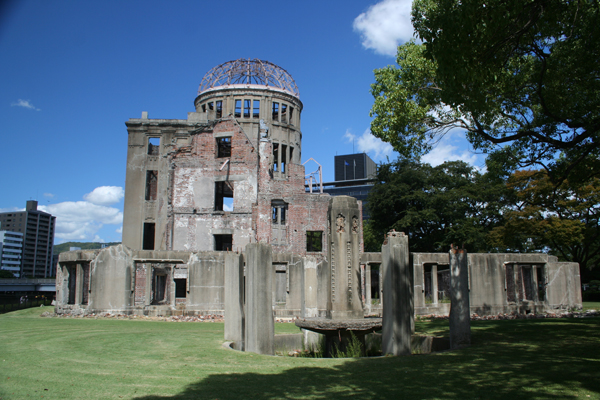
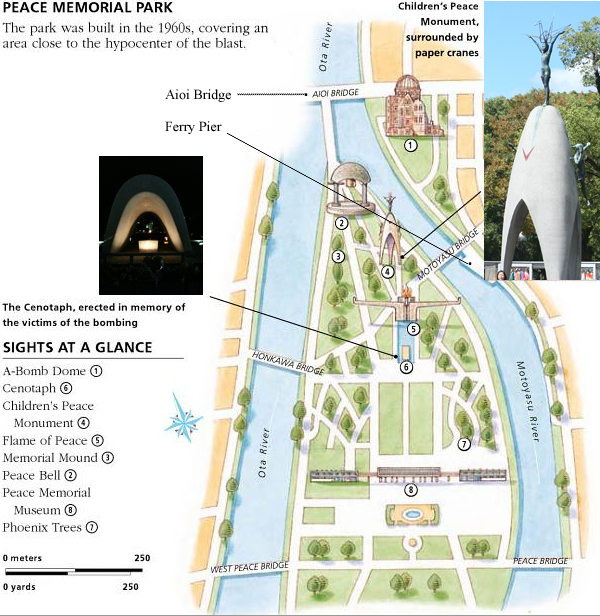
While this is of course appalling, what was less well known to me but which makes an interesting counterpoint is that in the same year incendiary attacks on Tokyo claimed the lives of 100,000 people. Somehow this made it a great deal easier for me to accept the concept put forth by advocates that by stopping the war in its tracks the atomic bombs saved more lives than they took.
Because the bomb exploded almost directly overhead, the dome and the building's vertical columns were able to resist the vertical downward force of the blast, leaving what we see preserved today. The center of the blast was 2000 feet (600 m) above the dome, having slightly missed the original target, the distinctive "T"-shaped Aioi Bridge. No surprise, everyone inside the building was killed instantly.
As we walked round to the river side, the silence was broken by a soprano singing an aria from the opposite bank. It was surreal, magical. There were only two or three performers, and only about a dozen people in the audience. It made no sense. But we could clearly hear it on our side of the river. I'm no opera buff, but the hauntingly beautiful piece sounded like something from Madama Butterfly, which is so perfect that I'm choosing to remember it that way. Update: January 2016 I was watching a documentary and immediately recognized the aria again, and this time there was a label: It was indeed Puccini, but the aria is "O Mio Babbino Caro" from the comic opera Gianni Schicchi and needless to say Wikipedia describes it as "one of the most popular arias in opera".
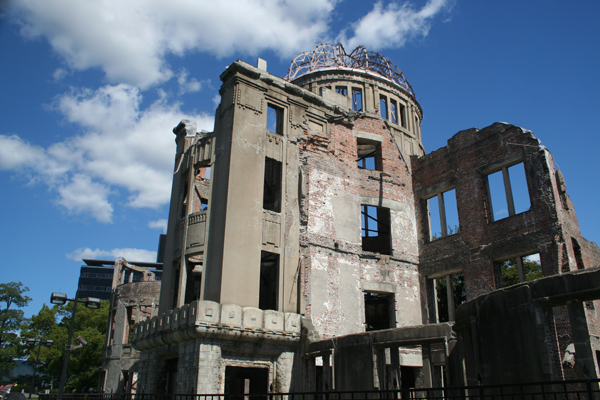 When the aria finished, the concert seemed to done, so we continued on our lap around the dome. The Aioi bridge is still there, and I remember it distinctly because as we walked across it, we made the left turn at the T-junction which took us into the main body of the park and Adam pondered how many T-shaped bridges there could be in the world—not many.
When the aria finished, the concert seemed to done, so we continued on our lap around the dome. The Aioi bridge is still there, and I remember it distinctly because as we walked across it, we made the left turn at the T-junction which took us into the main body of the park and Adam pondered how many T-shaped bridges there could be in the world—not many.
We walked half way down the Peace Garden, passed the point where the singers had been, to the next bridge crossing where the ferry landing was beaconing. We checked the time table and bought tickets for the next one 25 minutes later, giving us time to explore the area a little. To Adam this meant snack-hunting time, though it was still fairly early and we'd vowed to have lunch in Miyajima. So something small.
There was a nice little cafe right by the pier, but it was not "snacky" enough. In a classic example of "why do it the easy way?", Adam noticed an orange squeezer into which someone was feeding peeled, segmented, pieces of orange to make juice.
We went back across the bridge to the Information Shop, which proved to be more of a convenience store, and not a very good one of those either. Adam settled on a packet of chewy things, which were gone in 10 minutes.
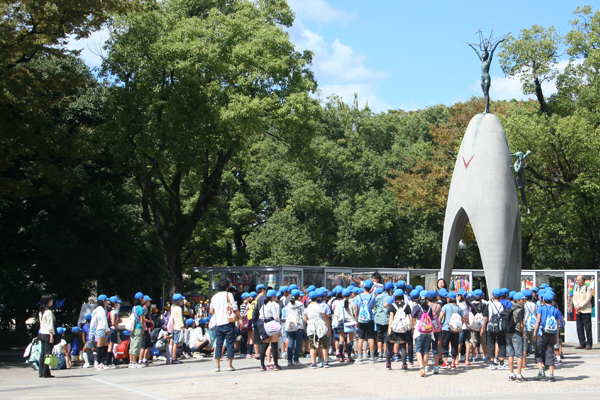 As we worked our way down the packet, we noticed the crowd around the Children's Peace Monument and wandered over to them. They were intently involved in some sort of extremely well-rehearsed—what? I assume it was some sort of dedication. Whatever it was, I was impressed: some kids recited for several minutes while others said something and the crowd responded like a preacher and the congregation. This went on for more than 10 minutes with no direction or interference from teachers or leaders as far as I could see. I'm guessing they were bringing paper cranes, because the telephone kiosks behind the memorial were crammed with thousands, millions, of strings of them, each labeled and documented with the dates and details of the school that brought them, from all over the world.
As we worked our way down the packet, we noticed the crowd around the Children's Peace Monument and wandered over to them. They were intently involved in some sort of extremely well-rehearsed—what? I assume it was some sort of dedication. Whatever it was, I was impressed: some kids recited for several minutes while others said something and the crowd responded like a preacher and the congregation. This went on for more than 10 minutes with no direction or interference from teachers or leaders as far as I could see. I'm guessing they were bringing paper cranes, because the telephone kiosks behind the memorial were crammed with thousands, millions, of strings of them, each labeled and documented with the dates and details of the school that brought them, from all over the world.
But then it was time to scoot back over the bridge to the ferry pier.
The ferry from the Peace Park was, of course, right on schedule, and we spent a delightful 45 minutes crossing the bay. While the ferry dodged the squares of man-made oyster beds we chatted to the two guys from Korea who seemed very keen to practice their English, while we all watched the young Japanese couple who were the only other people outside, bravely bearing the brunt of the splashes whipping over the starboard and windward side.
Miyajima and the Itsukushima Shrine 厳島神社
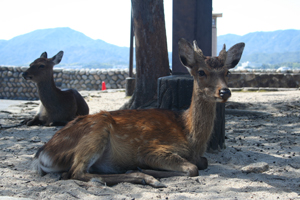 Transliterated from wikitravel-speak to RT prose: “Miyajima has been a holy place since 806 AD, when the monk Kōbō Daishi (774 - 835AD), one of the most famous Japanese Buddhist priests, ascended Mt. Misen and established the mountain as a site dedicated to the austerity and contemplative practices of Buddhism. Today, the island's Buddhist temples and Shinto shrines continue to maintain a close relationship. The island's sole town retains a classically Japanese Edo-era look. Deer wander freely through the streets and parks."
Transliterated from wikitravel-speak to RT prose: “Miyajima has been a holy place since 806 AD, when the monk Kōbō Daishi (774 - 835AD), one of the most famous Japanese Buddhist priests, ascended Mt. Misen and established the mountain as a site dedicated to the austerity and contemplative practices of Buddhism. Today, the island's Buddhist temples and Shinto shrines continue to maintain a close relationship. The island's sole town retains a classically Japanese Edo-era look. Deer wander freely through the streets and parks."
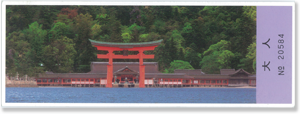 A few blocks of concrete warren have snuck in around the town, but the seafront promenade is particularly attractive, especially later in the day "when the rampaging tour groups head home and the stone lanterns are lit.” Phew. We narrowly avoided being part of the “rampaging tour groups” by dint of the stone lanterns being lit before we headed home.
A few blocks of concrete warren have snuck in around the town, but the seafront promenade is particularly attractive, especially later in the day "when the rampaging tour groups head home and the stone lanterns are lit.” Phew. We narrowly avoided being part of the “rampaging tour groups” by dint of the stone lanterns being lit before we headed home.
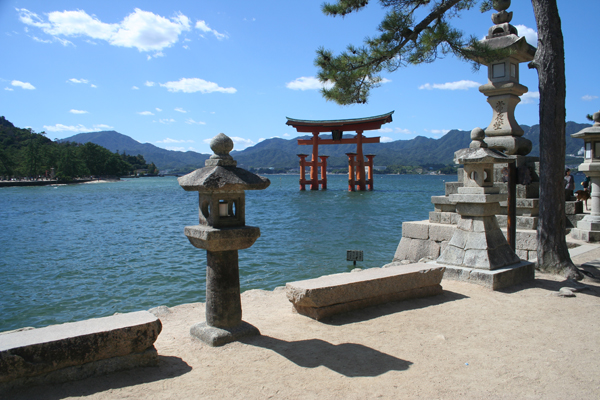 It's not just the deer that are protected. The entire island is a UNESCO World Heritage Site. The shrine is so sacred that to preserve its purity, for much of its history commoners were not allowed on the island. Commoners wishing to approach had to steer their boats through the torii. Since 1878 no births or deaths have been allowed near the shrine, an edict that one has to imagine has caused some unseemly scrambling at times, but since you can't be buried there anyway, at least you'd be making the off-island trip at one point or another. Even the trees are protected, and so the whole island is home to a virgin forest, and the variety of flora and fauna that comes with it.
It's not just the deer that are protected. The entire island is a UNESCO World Heritage Site. The shrine is so sacred that to preserve its purity, for much of its history commoners were not allowed on the island. Commoners wishing to approach had to steer their boats through the torii. Since 1878 no births or deaths have been allowed near the shrine, an edict that one has to imagine has caused some unseemly scrambling at times, but since you can't be buried there anyway, at least you'd be making the off-island trip at one point or another. Even the trees are protected, and so the whole island is home to a virgin forest, and the variety of flora and fauna that comes with it.
The terminal at Miyajima was larger than we expected with three different ferry lines servicing passengers, and a further dock for a car ferry. Why anyone would bring a car was a mystery: if there was a mile of road I'd be shocked. It was only a couple of hundred yards to the center of town, and there was nowhere else to go. Some roads were also closed to traffic. As advertised, there were way more deer than cars, and they were so at home that there were actually signs warning visitors to watch their bags—they were perfectly comfortable stealing things right out of your hands.
The unpaved road that ran the hundred or so yards from the terminal to town was right along the water front, and a stiff breeze whipped up an invisible micro-dust that scratched your throat just like it does on the beach. We hadn't taken more than 50 strides before we came across the first of the famous deer. A small crowd was trying to take its picture, but almost immediately there was another, and so on, so by the time we came to the entrance to the shrine itself, the deer were paying more attention to the visitors than the visitors were paying to them.
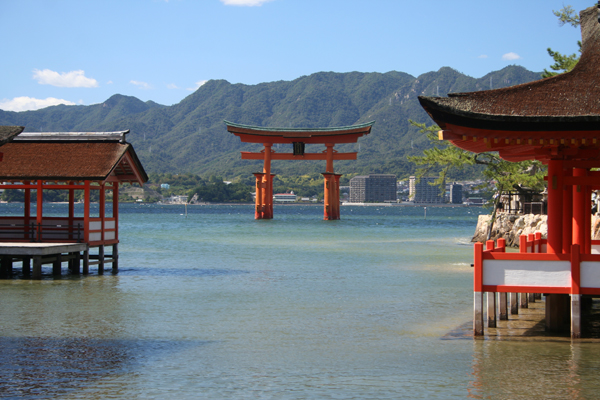 We stopped to take a series of pictures of the oh-so-famous Otorii (not just "gate" but "Grand Gate"), acclaimed with some justification IMHO, as one of the three most scenic views in Japan (Nihon Sankei). It was pretty much high tide, the weather was perfect, and the vermilion torii against the turquoise sea was photogenic by anyone's standards. I suspect we'd have been less euphoric if the Grand Gate was in the middle of its low tide mud flat. The current incarnation was built in 1875, but the first one was placed in the sea in the 12th century. It's about 50ft (16m) high.
We stopped to take a series of pictures of the oh-so-famous Otorii (not just "gate" but "Grand Gate"), acclaimed with some justification IMHO, as one of the three most scenic views in Japan (Nihon Sankei). It was pretty much high tide, the weather was perfect, and the vermilion torii against the turquoise sea was photogenic by anyone's standards. I suspect we'd have been less euphoric if the Grand Gate was in the middle of its low tide mud flat. The current incarnation was built in 1875, but the first one was placed in the sea in the 12th century. It's about 50ft (16m) high.
Moving on, we paid the customary entrance fee, and wandered around the Itsukushima Shrine itself. It was built almost entirely on a set of platforms or landings so that at high tide it appeared to be floating just above the surface of the water. It was busy. On one landing a wedding ceremony was taking shape (or at least the formal portrait part) and in the main sanctuary (honden) priests were taking offerings and bestowing blessings on about a dozen worshippers. Off to the side, a couple of young musicians accompanied the goings on with the whinings and strummings of traditional instruments. Leaving the shrine we wandered through the rest of the town (5 minutes) then to the back to check out the "ropeway." I was actually somewhat concerned about that: anything to do with actual ropes, actual heights, and actual drops was going to be an issue. Good news: ropeway more accurately translates directly to the English term cable car. Bad news: they wanted $20 for the experience. Adam nixed it.
We steered back into town. We quickly found the obligatory shopping mall, and we wandered through it trying not to trample on all the Australian school girls who were clogging everything. A special favorite was their purchases of 3 or 4 50 cent items that had to be individually wrapped by the shop keeper, who then when finally done made a face like they'd never seen a credit card before, so half the items had to go back because the customer only had about one dollar in actual cash.
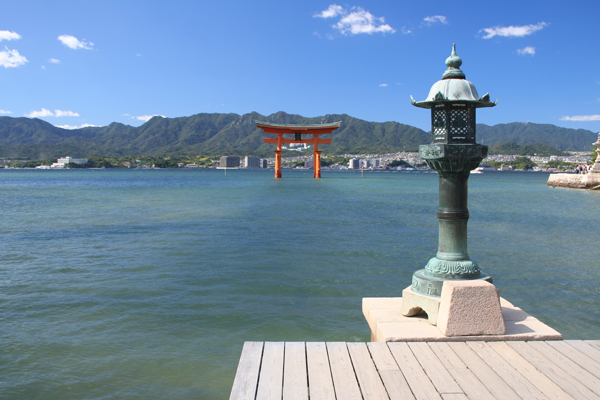
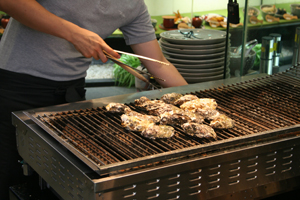
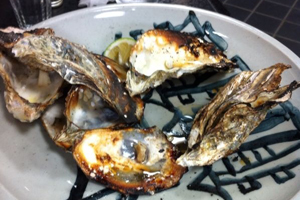
Finally I caught sight of this bbq chef turning oysters over on the grill outside a little restaurant. Me: "Lunch." Adam: "Obviously." Probably the best, and definitely the most expensive lunch we had all trip, but worth it. It was some small compensation for the fact that in the original plan this was one of the places we coulda, shoulda stayed at a ryokan. As we savored the moment, Adam had second thoughts about the ropeway. I was disappointed he didn't want to do it. It felt like a far bigger error to leave a potentially fabulous trip on the table than it was to discover that it was a complete bust and we'd wasted (only) $20. Adam: "Each." So I was delighted at the change of heart. Better still the compromise we agreed was a double-win: we'd halve the cost by agreeing to buy one-way tickets, thus obliging us to walk back down. We both knew that was the right thing to do anyway, but now we were in a bit of a time crunch.

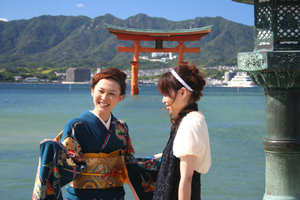
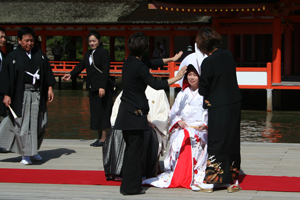
The sign we'd laughed at on the way down, now seemed eerily prescient: "10 minute walk. 7 if run a little." We ran a little, though we were actually less worried about missing the last ride up than we were about losing the daylight on the way back down.
Momijidani (Maple Leaf Valley) Park
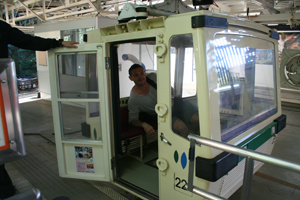
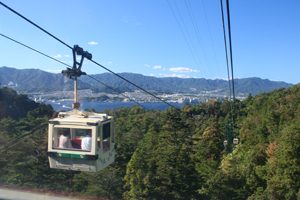
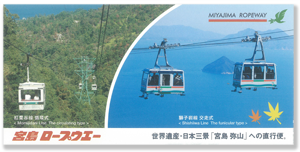
The view from the top was perfect on this sparkling clear day. It reminded me of Mt Washington, in that the last 10 - 15 feet of the "climb" were practically wheelchair accessible. Even for the able-bodied, stairs and hand-rails abounded. We spend some time just gazing out at the Seto inland sea, the container ships plying to and fro, and Hiroshima spread out along the coast line in the background. But the top was not the top. Vindicating our decision to walk down, the actual summit was 20 minutes further on, and part of the 90-120 minute walk "down." Again the path did not need to be marked, because it was paved. All we had to do was avoid the option to follow the route of the cable car which set off fairly obviously soon after turning our back on the cable car station, and then follow our noses as the path wound down and then up the saddle between the cable car station and the actual summit of Mt Misen. Shortly before arriving at the summit, we passed by a series of temples relating to Kōbō Daishi, who I swear was claimed to have climbed the peak to meditate, and to have started the fire that is still burning there, but neither the brochures I picked up, nor the Interweb can corroborate this for me. Anyway the sacred flame is important to our story, so remember it.
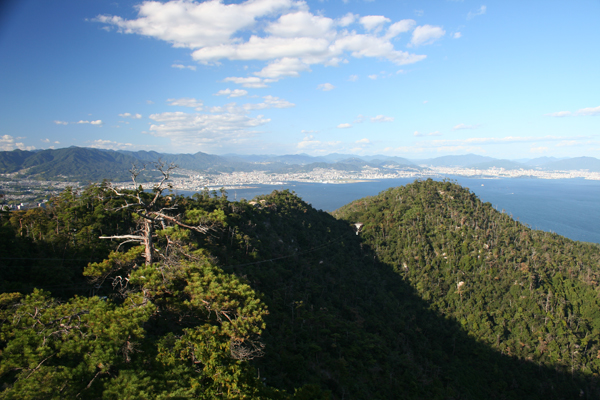
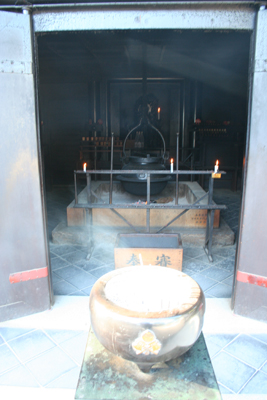
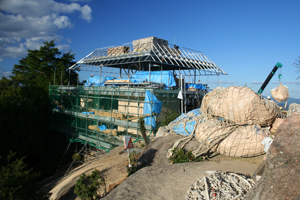 The actual summit (535m) was a surprise. A regular construction site, complete with forklift trucks and cranes. This new observatory will doubtless be fabulous when it is finished, but for now its construction prevented us from enjoying the view back down onto the town. Now we were seriously chasing the light and started to leg it down the mountain. A strapping Japanese tourist about Adam's age asked our advice about routes down, and agreed that making a mistake at this time of day wasn't worth the risk, and confirming that signage was just as lacking in Japanese as it was in English, decided to go back down the way she'd come up, and coincidently allowed her to stay fairly close to us.
The actual summit (535m) was a surprise. A regular construction site, complete with forklift trucks and cranes. This new observatory will doubtless be fabulous when it is finished, but for now its construction prevented us from enjoying the view back down onto the town. Now we were seriously chasing the light and started to leg it down the mountain. A strapping Japanese tourist about Adam's age asked our advice about routes down, and agreed that making a mistake at this time of day wasn't worth the risk, and confirming that signage was just as lacking in Japanese as it was in English, decided to go back down the way she'd come up, and coincidently allowed her to stay fairly close to us.
I was frankly relieved, and made sure we never left her far behind, and I'm pretty certain she was doing the same. The walk was pleasant enough, the fading light was accompanied by a drop in temperature, and downhill is easy going, but the virgin forest blocked the view pretty much all the way down. After about 20 minutes we passed an American still on his way up. Seriously dude? But he was the sort of punk who was not about to take any advice, and for whom I had no desire to provide with any, so we gave him our 20 minute estimate for the time still needed to get to the top, and skipped on downwards without giving him another thought. Well, uncharitably that's not true. With the lights on in town, and the sun right on the horizon as we finally hit the outskirts of town, I did wonder if he'd still only be 40 minutes behind as he groped his way home.
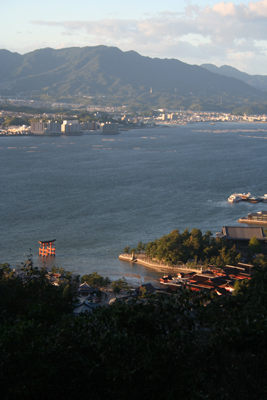
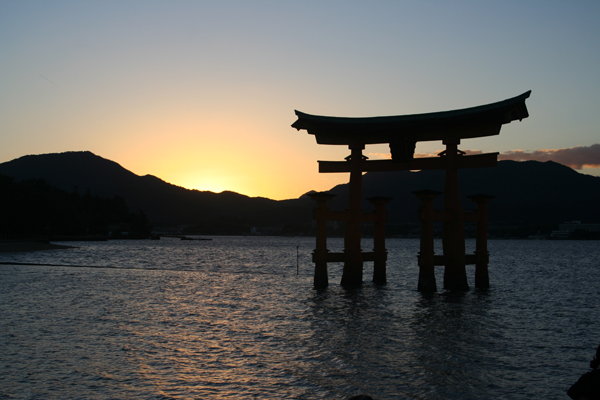
With spectacular timing, this meant we were back at Otorii just in time for sunset, the walk back to the ferry terminal in time for the stone lanterns to be lit so we we no longer classified as rampaging tourists, and stepped onto the ferry just as they pulled back the gang-plank. The ride was free, courtesy of our JR Passes. Ten minutes later we were on the mainland, and 10 more minutes saw us on a packed train back to Hiroshima. It took a surprising amount of time, and made me even more glad we'd taken the expensive ferry from the Peace Park. It would actually have taken longer and been waaay less fun to come out here on the train.
Back in Hiroshima
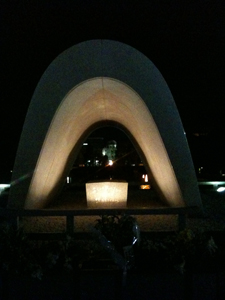 Though dark, it was still only about 7pm when we arrived back in Hiroshima. It was a no-brainer that the right thing to do at this early hour was to return to the Peace Park and repeat the whole thing, seeing what darkness added to the experience. Now old hands, we jumped on the tram and took it all the way to the park this time. We did a slow lap around the A-bomb Dome, then crossed the Aioi bridge and walked back through the park. This time when we got to the Children's Monument, we kept on going, and almost immediately came to the Flame of Peace. And here's the connection to the temples on Mt Misen. The Flame of Peace was lit from that 1000yr-old flame on Mt Misen. It will only be extinguished when the last nuclear weapon is dismantled.
Though dark, it was still only about 7pm when we arrived back in Hiroshima. It was a no-brainer that the right thing to do at this early hour was to return to the Peace Park and repeat the whole thing, seeing what darkness added to the experience. Now old hands, we jumped on the tram and took it all the way to the park this time. We did a slow lap around the A-bomb Dome, then crossed the Aioi bridge and walked back through the park. This time when we got to the Children's Monument, we kept on going, and almost immediately came to the Flame of Peace. And here's the connection to the temples on Mt Misen. The Flame of Peace was lit from that 1000yr-old flame on Mt Misen. It will only be extinguished when the last nuclear weapon is dismantled.
At the other end of the pond was the Centotaph, which contains the names of all the victims, and is inscribed "Rest in Peace. We will never repeat the error." But we saw no evidence of this, and I only read about it while doing this write-up. But it was powerful enough, pointing as it did to the A-Bomb Dome in the distance, and flickering in between the two, the Flame of Peace. By far the best thing about the park. After that, it sorta goes downhill rapidly. Open grassy spaces, boring, UN-like concrete buildings, a Washington Mall waiting for all its monuments to get added over time. Alexis assured me later that the museum would have been well worth a visit, but it was being locked up as we got there so we didn't have a choice.
We came out of the other end of the park, crossed the Peace Bridge, and that was the end of the show. A long day, and all that was left was to find a nice cheap noodle joint for a bowl of something hot, and a glass of something cold, and then back to the room to crash.
Our room was hot and dark when we entered. That's because the key to our room both here and in Kyoto had a magnetic fob attached to it, that had to be wedged into its own little pocket on the wall in the room. Only then did anything work. In the morning of course, the inverse: as soon as you took it out to lock the door, absolutely everything in the room died. And then breakfast: what a surprise! Buffet-style pickles! Plus all the other staples of course: rice, miso soup, eggs. Several confused but determined souls were carefully trying to spread peanut-butter onto toast using chopsticks. They were Japanese. Us foreigners stuck to our favorite rice, miso soup and pickles.
As we left the hotel, the taxi that had sat right outside the door the entire time we were eating breakfast pulled away leaving us standing on the sidewalk. As we stood there muttering obscenities not one but two doormen came out and asked if we were catching the Shinkansen. Er, yes, as a matter of fact. How did you guess? They ushered me and the bags into a shuttle van while Adam returned inside with one of them to sign some sort of register that we were using the van. As we drove off, we found a timetable on the inside of the door, indicating that we were right on time for the 7:40am shuttle. We just happened to be in the right place at the right time. Score. Next stop: Himeji.